Due to the high carbon dioxide (CO2) and chloride content in natural gas produced by a gas field in Western China, a high-performance duplex stainless steel (SS) (UNS S31083) was chosen for gas gathering and transmission piping in this area. While UNS S31083 showed superior chloride and CO2 resistance in former studies, no performance history was available for the strongly corrosive soil in Western China’s Yardang landform. To fill this gap, weight loss coupon testing was carried out, using 54 coupons that were buried and excavated in batches after one-year intervals. Weight loss, corrosion morphology, and calculated corrosion rates were evaluated. Results indicated that UNS S31083 experienced only minor corrosion, even after three years’ burial; and there is no need to adopt extra cathodic protection for the pipes buried in this area.
The natural gas produced in a gas field in Western China contains high concentrations of carbon dioxide (CO2) and chloride, which are the main safety concerns for downhole tubing, gas gathering lines, and transmission pipes. The produced gas is highly corrosive, with CO2 content up to 0.72%, chloride ion content up to 10,677 mg/L, dissolved gas content up to 2,206 mg/L, and formation water with pH ranging from 5.91 to 7.23. This environment presents huge challenges for internal corrosion protection of the piping.
In addition, the soil environment in this area is classified as highly corrosive. This gas field is located deep inland in Western China in the Yardang landform, which has been formed by wind erosion over hundreds of thousands of years. The earth’s surface here is mainly covered by gravel with almost no vegetation. Soluble salt content is 0.35 to 6.08%, and soil resistivity is 5.15 to 15.08 Ω·m. When gas pipelines were buried in this Yardang soil, both the aggressive internal conditions and the external corrosive environment presented tremendous challenges to safe operation.
Taking all of these factors into consideration, along with the critical importance of this high yield gas field, material selection justified the use of a corrosion-resistant alloy. In the engineering phase, duplex stainless steel (SS) was chosen for its resistance to chloride and CO2 corrosion. AVESTA SAF 2205† (UNS S31083) was then selected for almost all gas gathering transmission trunk pipelines in this gas field. UNS S31083 duplex SS is a second generation, new-style duplex SS that contains nitrogen as well as 22% Cr, 3% Mo, and 7% Ni. It has nearly equal proportions of ferrite and austenite after solution treatment. Its composition and microstructure determine its superior mechanical properties and resistance to several types of corrosion: uniform, pitting, crevice, and stress corrosion cracking (SCC).
An analysis of UNS S31083 duplex SS in corrosive conditions with CO2, water, and chlorides was studied, and related experiments were performed in domestic research institutions in China.1-4 All of the results concluded that UNS S31083 showed superior chloride and CO2 resistance; however, no previous research was found regarding the external corrosion resistance of this alloy when buried in the highly corrosive Yardang soil.
To investigate the corrosion behavior of UNS S31083 duplex SS in Yardang soil and to determine the metal’s cathodic protection (CP) requirements, weight loss coupon testing was conducted.
Experimental Procedure

Materials
UNS S31083 (SAF 2205) coupons were provided by AVESTA. The chemical composition is presented in Table 1. Anode materials—zinc alloy anodes and magnesium alloy anodes—were provided by Jiaozuo YIRUI Alloy Material Co., Ltd.
Test Method
Weight loss coupon testing was adopted in accordance with Chinese Standard SY/T0029-2012.5 Fifty-four UNS S31083 coupons were buried in Yardang soil at a depth of 1.5 m. Bare coupons were buried either without and with sacrificial anode CP.
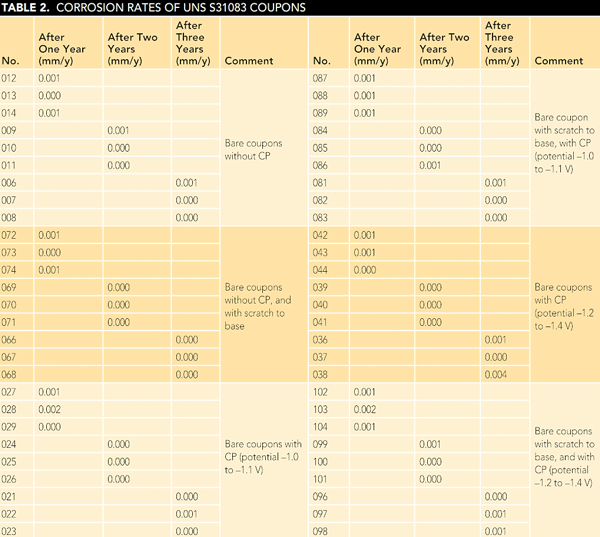
The 54 coupons were divided into six groups (Table 2):
• UNS S31083 bare coupons without CP included (a) nine unmodified coupons and (b) nine coupons that had been scratched at the base.
• UNS S31083 bare coupons with sacrificial CP using zinc alloy anodes (CP potentials equaled –1.0 to –1.1 V) included (a) nine unmodified coupons and (b) nine coupons that had been scratched at the base.
• UNS S31083 bare coupons with sacrificial CP using magnesium anodes (CP potential equaled –1.2 to –1.4 V) included (a) nine unmodified coupons and (b) nine coupons that had been scratched at the base.
Coupons were excavated after one, two, and three years in batches that included three from each of the six groups. Laboratory testing and analysis were conducted for each batch to determine corrosion morphology, composition of corrosion products, and corrosion rates based on weight loss.
Results and Discussion
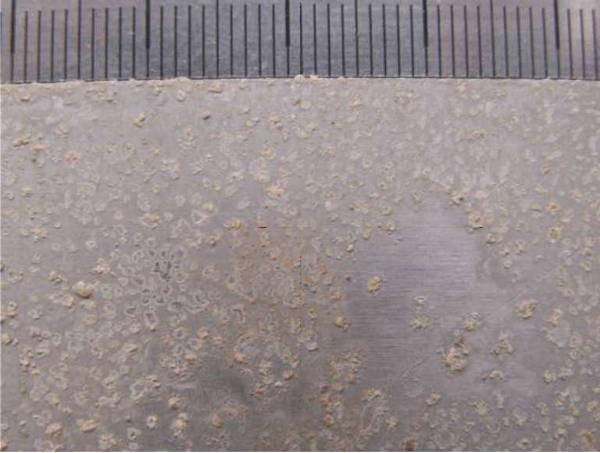
Corrosion Morphology
For each batch of coupons that was excavated, the coupon surfaces were covered with sand, grain, and other materials; however, only five out of 54 coupons still had grey-white material attached after surface cleaning with deionized water (Figure 1). The rest of the coupons had bright metal surfaces with no visible corrosion products attached and no visible sign of corrosion. Notably, corrosion of the coupons with scratches in the base was essentially the same as for those without scratches. Figure 2 shows a scratched coupon with no visible corrosion in the localized area along the cutting line where the passivation membrane was damaged. That could be attributed to the strong self-passivation ability of UNS S31083. In spite of the destruction of the surface passivation film, this material was able to self-repair, thus preventing corrosion from developing.
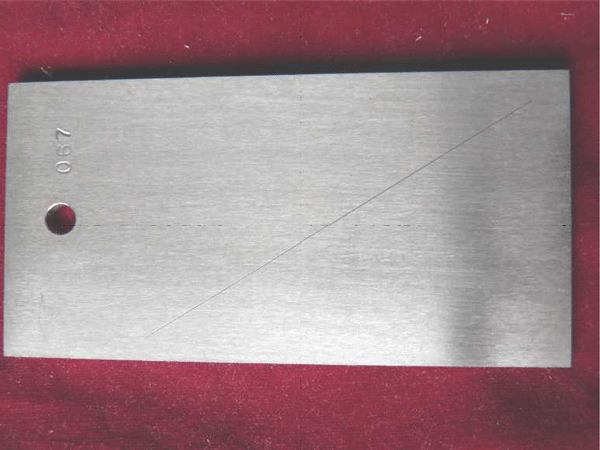
Analysis of Corrosion Product
Scanning electron microscopy (SEM) (JSM-5600LV scanning electron microscope, JEOL, Ltd.†) and energy spectrum analysis were utilized to examine the grey-white surface material that formed on coupon no. 022, a coupon with CP (potential of –1.0 to –1.1 V) and buried for three years. Analysis results are shown in Figures 3 and 4. The surface material was mainly composed of Ca, O, C, and Si, plus some other elements. Meanwhile, the presence of Cr, Mo, and Ni was not indicated, which confirmed that UNS S31083 didn’t undergo any distinguishable, corrosion-induced change in composition.
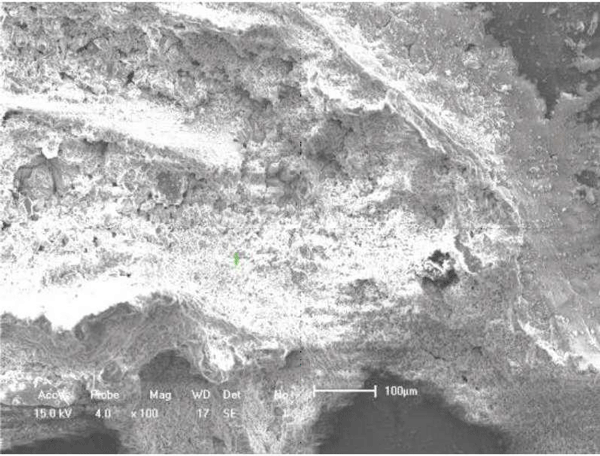
The grey-white material that formed on the surface of coupon no. 022 was further tested using an x-ray diffractometer (XRD-6100† x-ray diffractometer, Shimadzu Corp.). Figure 5 shows that the product is mainly calcium carbonate (CaCO3) and silicon dioxide (SiO2). Neither energy spectrum analysis nor x-ray diffraction (XRD) analysis gave any indications of Cr, Ni, Mo, or N in the composition of the attached materials. XRD results were consistent with those of energy spectrum analysis, which confirmed that no corrosion had taken place on those coupons.
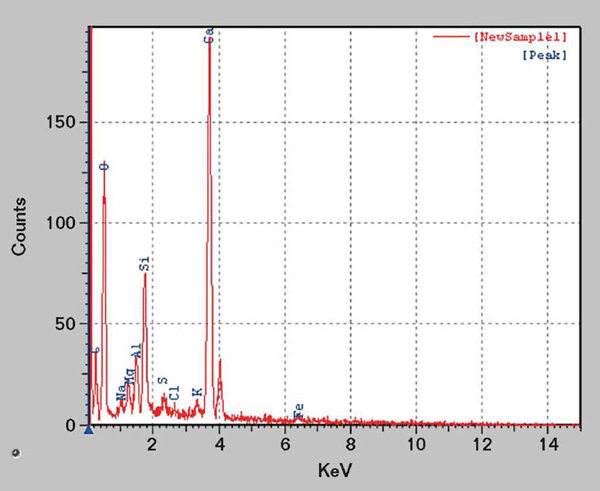
Average Corrosion Rate Results
The average corrosion rate, based on weight losses of the coupons, was calculated according to Equation (1), the formula in SY/T0029-2012:

where V is the average corrosion rate (mm/y); W is the weight loss of the coupon (g); A is the exposure area of the coupon (cm2); t is the burial time (h); and D is the density of coupon steel (g/cm3).
Average corrosion rates of UNS S31083 coupons are shown in Table 2.
Table 2 shows that UNS S31083 bare coupons without CP were only slightly corroded even after three years of burial, with average corrosion rates in the range of 0.000 to 0.001 mm/y. The other two groups of coupons with sacrificial anode CP (one group with zinc sacrificial anodes and one group with magnesium sacrificial anodes) showed no significant corrosion. The results indicate that extraordinary CP was unnecessary for this piping.
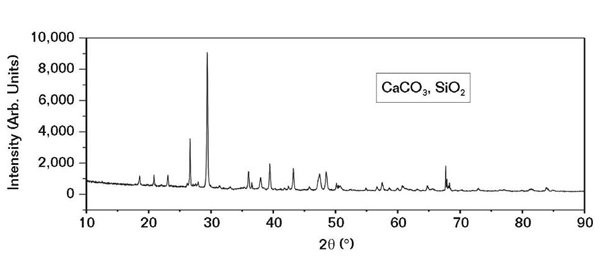
Conclusions
The corrosion behavior of UNS S31083 in Yardang soil was studied to determine the necessity for CP based on weight loss coupon testing. Coupons were buried in Yardang soil and excavated in batches for examination after one-year intervals. The excavated coupons were cleaned and weighed to quantify the weight loss. The attached materials were analyzed to characterize any corrosion.
Testing of the 54 buried coupons resulted in the following conclusions:
• In spite of the highly corrosive Yardang soil environment, the UNS S31083 duplex SS coupons were only slightly corroded after three years. The calculated average corrosion rate is on the order of 0.000 to 0.001 mm/y, indicating the superior soil corrosion resistance of this alloy. Coupons with scratches at their base looked almost the same as those without scratches. The absence of corrosion where the protective surface layer had been disrupted can be explained by the self-repairing capability of this duplex SS alloy.
• There was no discernable difference between coupons without and with CP using zinc or magnesium sacrificial anodes. Accordingly, there is no need to adapt additional CP for UNS S31083 pipes buried in the aggressive soils of this area.
• Based on the testing results of 54 coupons for three years, the selection of UNS S31083 for gas gathering pipelines and gas transmission pipelines in the Yardang soil environment is appropriate and justified.
†Trade name.
References
1 L. Hongxian, F. Yuguang, Z. Sanping, “Study on Uniform Corrosion Resistance of 22Cr Duplex Stainless Steel,” J. Corrosion & Protection in Petrochemical Industry 25, 6 (2008): pp. 10-12.
2 C. Hongzhou, W. Chiyu, X. Tianmei, et al., “Protection Countermeasures of CO2 Corrosion in Kela-2 Gas Field,” J. Corrosion & Protection 28, 10 (2007): pp. 545-547.
X. Hui, L. Hongxian, Z. Guoxian, “Research on Pit Corrosion Characteristics of 22Cr Duplex Stainless Steel,” J. Natural Gas and Oil 5 (2007).
4 X. Hui, Z. Guoxian, “Corrosion Resistance of 00Cr22Ni5Mo3N Duplex Stainless Steel,” J. Inner Mongolia Petrochemical Industry 12 (2006): pp. 36-37.
5 SY/T0029-2012, “Specification of Application for Underground Steel Coupons” (Singapore: Chinese Standards, 2012).